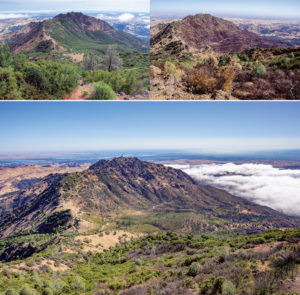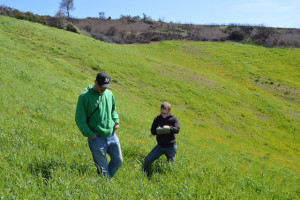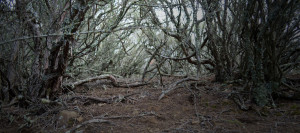At Cal football games in the 1940s, when smoking was still permitted, as many as 20,000 simultaneous cigarettes would create a hazy cloud that hung over Memorial Stadium. That, says James Agee in Fire Ecology of the Pacific Northwest Forests, is when the beetles would show up. Masses of dark-bodied large insects would descend out of the sky, “alighting on the clothing or even biting” spectators. The phenomena, Agree writes, appeared “more disturbing to fans than a Stanford touchdown.”
The beetles were charcoal beetles, programmed by evolution to seek out forest fires for laying their eggs, and confused by human artifice into choosing the wrong spot. There was at least a scientific upside. The genus Melanophila was largely unknown to entomologists until complaints from people at stadiums or oil fires prompted study into their fire-chasing and swarming behavior.
Charcoal beetles behave at fires the way locusts behave in cornfields, or like humans at a football game: they congregate en masse, they eat a lot, and they find mates. The beetles enter a fire to mate while it’s still burning and once the flames have subsided, females lay eggs under the bark of burned trees. The larvae depend on the woods of freshly-killed trees because they cannot cope with the living tree’s chemical defenses. This after-fire niche provides a no-pressure environment nearly free of predators and defenses.
This year in California has been a banner year for the beetles. On Mount Diablo, many pines were drought-dried, making the Morgan fire burn exceptionally hot, down to the roots, where pits of embers remained like a dug-out firepit. Dylan Jorgensen, a CalFire firefighter who fought the Morgan Fire, said the beetles were particularly fond of these stump holes and would bob up and down in them to lay eggs — earning the nickname “stump humpers” from the firefighters.
Jorgensen encountered the swarming beetles during a process the firefighters call “mopping up.” After flames have subsided, firefighters find hot spots near the ground and spray water on the burning embers. Flipping and overturning smoldering logs to spray, Jorgensen said, “infuriated the beetles like knocking over a beehive.”
To protect themselves against the darting insects, the firefighters wore bee veils. The beetles emerged from their mating stages in the burned or burning trees to swarm, rising with the smoke and sizzling crackle of extinguished embers. Firefighters recalled that everywhere skin was exposed, beetles scratched and prodded — mostly around faces and necks, and between the small space between helmet and face. Jorgensen described a feeling of relentless buzzing in his hair, firefighters “ripping their helmets off like feeling a bee in your shirt”, and dancing and shaking to get the beetles off of them.
Mike Marcucci, a battalion chief for CalFire, said he accepts black swarms of beetles as just another part of the job: they’ve appeared at nearly every forest fire he’s been to in the Sierra or Coast Ranges.
All of which is an indication that these animals are really good at their jobs. The beetles locate the next fire by following infrared radiation emitted by the fire. Instead of emitting smells, the beetle’s “armpits” contain infrared “smell” sensors — similar to the pits that pit vipers use to locate warm-blooded prey. Each sensor contains a sphere of water that, when heated, expands to press a button receptor under the second pair of legs, triggering the nervous system, and alerting the beetle of a distant fire. The beetles fly with their second pair of legs raised into the air, exposing the sensors to the distant fire source.
In 1925, lightning ignited a large oil depot near Coalinga, California. Without fail, the beetles showed up in large conflagrations. Whether they found a suitable spot to mate or not is still unknown but at the time of the fire at Coalinga, the closest recently-burned forest was over 150 km away. Evidently, these beetles did not use visual cues like smoke or flames to track the fire. In 2012, scientists Helmut Schmitz and Herbert Bousack found that the beetles become aware of fires when they are 130 kilometers away. That’s about the distance between San Francisco and Sacramento. Apparently, the biological infrared receptors are more sensitive than infrared sensors currently on the market.
Catching a glimpse of one of these beetles doesn’t necessarily spell impending fire disaster, Kipling Will, an entomology professor at University of California, Berkeley, said; they may just be passing through searching for the next fire.
Their transient, fire-loving behavior has made their remaining natural history rather unknown to entomologists. Will has surveyed Mount Diablo’s insects in the past and said the beetles aren’t there at all when there hasn’t been a recent fire. But now with the “big flush” of a fire and drought, he said they’ll show up and “have a field day as a finishing touch for the weakened trees.”





